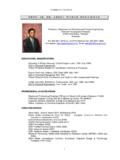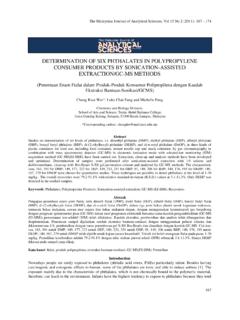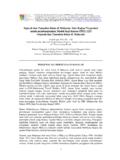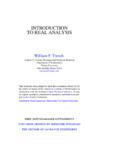Transcription of Geophysical Surveying Using Magnetics Methods Introduction
1 EBS 309 : Geofizik Carigali Magnetik Dr. Kamar Shah Ariffin Page 1 of 35 Geophysical Surveying Using Magnetics Methods Introduction Introduction to Magnetic Exploration - Historical Overview Unlike the gravitational observations described in the previous section , man has been systematically observing the earth's magnetic field for almost 500 years. Sir William Gilbert (left) published the first scientific treatise on the earth's magnetic field entitled De magnete. In this work, Gilbert showed that the reason compass needles point toward the earth's north pole is because the earth itself appears to behave as a large magnet.
2 Gilbert also showed that the earth's magnetic field is roughly equivalent to that which would be generated by a bar magnet located at the center of the earth and oriented along the earth's rotational axis. During the mid-nineteenth century, Karl Frederick Gauss confirmed Gilbert's observations and also showed that the magnetic field observed on the surface of the earth could not be caused by magnetic sources external to the earth, but rather had to be caused by sources within the earth. Geophysical exploration Using measurements of the earth's magnetic field was employed earlier than any other Geophysical technique. von Werde located deposits of ore by mapping variations in the magnetic field in 1843. In 1879, Thalen published the first Geophysical manuscript entitled The Examination of Iron Ore Deposits by Magnetic Measurements.
3 Even to this day, the magnetic Methods are one of the most commonly used Geophysical tools. This stems from the fact that magnetic observations are obtained relatively easily and cheaply and few corrections must be applied to the observations. Despite these obvious advantages, like the gravitational Methods , interpretations of magnetic observations suffer from a lack of uniqueness. Similarities Between Gravity and Magnetics Geophysical investigations employing observations of the earth's magnetic field have much in common with those employing observations of the earth's gravitational field. Thus, you will find that your previous exposure to, and the intuitive understanding you developed from Using , gravity will greatly assist you in understanding the use of Magnetics . In particular, some of the most striking similarities between the two Methods include: Geophysical exploration techniques that employ both gravity and Magnetics are passive.
4 By this, we simply mean that when Using these two Methods we measure a naturally occurring field of the earth: either the earth's gravitational or magnetic fields. Collectively, the gravity and Magnetics Methods are often referred to as potential Methods *, and the gravitational and magnetic fields that we measure are referred to as potential fields. EBS 309 : Geofizik Carigali Magnetik Dr. Kamar Shah Ariffin Page 2 of 35 Identical physical and mathematical representations can be used to understand magnetic and gravitational forces. For example, the fundamental element used to define the gravitational force is the point mass.
5 An equivalent representation is used to define the force derived from the fundamental magnetic element. Instead of being called a point mass, however, the fundamental magnetic element is called a magnetic monopole. Mathematical representations for the point mass and the magnetic monopole are identical. The acquisition, reduction, and interpretation of gravity and magnetic observations are very similar. *The expression potential field refers to a mathematical property of these types of force fields. Both gravitational and the magnetic forces are known as conservative forces. This property relates to work being path independent. That is, it takes the same amount of work to move a mass, in some external gravitational field, from one point to another regardless of the path taken between the two points.
6 Conservative forces can be represented mathematically by simple scalar expressions known as potentials. Hence, the expression potential field. Differences Between Gravity and Magnetics Unfortunately, despite these similarities, there are several significant differences between gravity and magnetic exploration. By-and-large, these differences make the qualitative and quantitative assessment of magnetic anomalies more difficult and less intuitive than gravity anomalies. The fundamental parameter that controls gravity variations of interest to us as exploration geophysicists is rock density. The densities of rocks and soils vary little from place to place near the surface of the earth. The highest densities we typically observe are about gm/cm^3 , and the lowest densities are about gm/cm^3.
7 The fundamental parameter controlling the magnetic field variations of interest to us, magnetic susceptibility, on the other hand, can vary as much as four to five orders of magnitude*. This variation is not only present amongst different rock types, but wide variations in susceptibility also occur within a given rock type. Thus, it will be extremely difficult with magnetic prospecting to determine rock types on the basis of estimated susceptibilities. Unlike the gravitational force, which is always attractive, the magnetic force can be either attractive or repulsive. That is, mathematically, monopoles can assume either positive or negative values. Unlike the gravitational case, single magnetic point sources (monopoles) can never be found alone in the magnetic case. Rather, monopoles always occur in pairs.
8 A pair of magnetic monopoles, referred to as a dipole, always consists of one positive monopole and one negative monopole. A properly reduced gravitational field is always generated by subsurface variations in rock density. A properly reduced magnetic field, however, can have as its origin at least two possible sources. It can be produced via an induced magnetization, or it can be produced via a remanent magnetization. For any given set of field observations, both mechanisms probably contribute to the observed field. It is difficult, however, to distinguish between these possible production mechanisms from the field observations alone. EBS 309 : Geofizik Carigali Magnetik Dr. Kamar Shah Ariffin Page 3 of 35 Unlike the gravitational field, which does not change significantly with time**, the magnetic field is highly time dependent.
9 *One order of magnitude is a factor of ten. Thus, four orders of magnitude represent a variation of 10,000. **By this we are only referring to that portion of the gravity field produced by the internal density distribution and not that produced by the tidal or drift components of the observed field. That portion of the magnetic field relating to internal earth structure can vary significantly with time. Magnetic Monopoles Recall that the gravitational force exerted between two point masses of mass m1 and m2 separated by a distance r is given by Newton's law of gravitation, which is written as where G is the gravitational constant. This law, in words, simply states that the gravitational force exerted between two bodies decreases as one over the square of the distance separating the bodies.
10 Since mass, distance, and the gravitational constant are always positive values, the gravitational force is always an attractive force. Charles Augustin de Coulomb, in 1785, showed that the force of attraction or repulsion between electrically charged bodies and between magnetic poles also obey an inverse square law like that derived for gravity by Newton. To make the measurements necessary to prove this, Coulomb (independently of John Michell) invented the torsion balance. The mathematical expression for the magnetic force experienced between two magnetic monopoles is given by where is a constant of proportionality known as the magnetic permeability, p1 and p2 are the strengths of the two magnetic monopoles, and r is the distance between the two poles. In EBS 309 : Geofizik Carigali Magnetik Dr.













